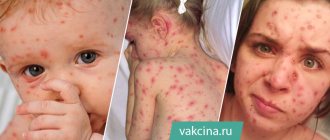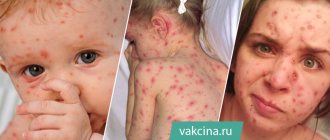Questions:
- What is pyoderma?
- Causes of pyoderma
- Symptoms
- Types of pyoderma
- How is pyoderma transmitted?
- Chronic pyoderma
- Pyoderma in children
- Pyoderma in newborns
- Treatment of pyoderma
- Is it possible to treat pyoderma at home?
- At what age can Timogen cream be used in children?
- Treatment with folk remedies
- Prevention
Medical specialists answer frequently asked questions from users
What is pyoderma?
Pyoderma is a disease of purulent skin lesions, most often caused by pyogenic (pyogenic) cocci - streptococci and staphylococci, which are constantly found on the skin and mucous membranes. In addition to these pathogens, there are other microorganisms on human skin, such as pseudodiphtheria bacillus, yeast-like fungi, etc., which can also cause disease under certain conditions. The name of the disease comes from the Greek py'on - pus and de'rma - skin). This is one of the most common skin diseases.
to the begining
Diagnosis of pyoderma
The reason for testing for pyoderma is the appearance of inflammatory elements on the patient’s skin. The doctor’s task is to establish the exact type of disease and its severity.
For this purpose, bacteriological examination of the contents of ulcers and determination of sensitivity to antibacterial drugs are used. This way it is possible to determine which specific bacteria caused the inflammation. For deep tissue inflammation, a biopsy is also used.
In addition to examining the inflammatory elements directly, the patient is prescribed blood tests (clinical, blood glucose levels and other biochemical indicators), urinalysis, immunological and histological examination. This set of procedures allows you to accurately determine the pathogen, causes and type of skin disease.
Also, if necessary, the dermatologist prescribes consultations with other specialists - an endocrinologist, a therapist. A differential diagnosis is mandatory to exclude diseases with similar manifestations: tuberculosis, syphilis, candidiasis, microbial eczema, parasitic and fungal skin lesions.
Causes of pyoderma
Frequent causes of pyoderma are hypothermia and overheating of the body under production conditions.
When the body cools, blood circulation is disrupted, swelling of the skin occurs, sebum secretion and sweating decrease, as a result, the skin becomes dry and flaky, making it easily susceptible to injury and infection.
Overheating of the body leads to loss of water and chlorides (mineral salts), the latter affecting the vascular system and the functions of the kidneys and skin.
The possibility of pyogenic infection can be increased by additional irritants like oils and other contaminants.
The skin is able to destroy microorganisms that fall on its surface due to the acidity of the skin (pH), the so-called “acid protective coat of the skin.” Bacterial infection occurs faster in those areas of the skin where the pH is higher - these are the armpits, interdigital folds of the feet, and inguinal folds. Therefore, pathological changes occur more often in these places.
to the begining
Cause
The bottom line is that our skin is exposed to many microorganisms. Some of them, when the body’s protective functions are weakened, can cause pyoderma. This is due to the fact that microorganisms secrete certain toxins, which affect the skin.
The causes of pyoderma can be:
- lack of personal hygiene;
- severe decrease in immunity;
- microtraumas;
- hypothermia and overheating;
- pathologies of the digestive system;
- problems with hematopoietic functions;
- vitamin imbalance;
- obesity or exhaustion;
- presence of diabetes mellitus;
- the skin's tendency to excessively produce sebum;
- changes in hormonal levels;
- taking certain medications.
Since the causes of pyoderma are so diverse, it is not always possible to immediately understand what is wrong and prescribe effective treatment. A thorough diagnosis of the patient is required. The matter is further complicated by the fact that there are so many variants of this disease and its varieties.
Kinds
Superficial staphyloderma
The most common are folliculitis, sycosis vulgaris, ostiofolliculitis, and epidemic pemphigus of newborns. Ostiofolliculitis is an abscess surrounded by a zone of mild hyperemia, penetrated by hair. With folliculitis, the abscess is located against the background of a painful bluish-pink nodule. Vulgar sycosis is called multiple, recurrent ostiofolliculitis and folliculitis against the background of thickened bluish-pink skin, often in the mustache and beard area. Epidemic pemphigus of newborns is a severe, contagious disease of the first days of life. In addition to the palms and soles, the child’s skin becomes covered with large blisters, which later form crusts and extensive erosions.
Deep staphyloderma
The most famous are boils, carbuncles, and hidradenitis. The boil develops from ostiofolliculitis or folliculitis. First, a painful node appears in the thickness of the skin, which enlarges; a large pustule is formed in its center, which opens with the subsequent separation of the purulent-necrotic core. After which, the resulting ulcer gradually scars.
A carbuncle is several boils located in one place, closely adjacent to each other, against the background of a general dense, edematous infiltrate of a bluish-purple color. The deep ulcer formed after opening the carbuncle heals with a rough scar. Hidradenitis is a purulent inflammation of the apocrine sweat glands, often recurrent. In the armpits, anogenital area, and around the nipples of the mammary glands, deep, painful nodes appear, over which the skin is colored bluish-pink. The nodes are opened with the release of liquid pus.
Superficial streptoderma
The most common is streptococcal impetigo . This disease occurs more often on the face in children and young women. Against the background of slightly hyperemic skin, phlyctens (bubbles with opalescent contents) appear, shrinking into yellowish crusts or eroding. When staphylococci are attached, the crusts become greenish-yellow or sometimes hemorrhagic ( impetigo vulgaris ). Without treatment, the disease can affect large areas of the skin. Lichen simplex , more often in children, is an abortive form of streptococcal impetigo. It is expressed by the appearance of whitish or light pink, slightly flaky spots.
Deep streptoderma
Vulgar ecthyma . With this disease, deep pustules appear, shrinking into purulent-bloody crusts, under which ulcers are found. After 2-3 weeks, the ulcers heal.
to the begining
Material and methods
At the screening stage, 55 patients were observed. Before prescribing systemic therapy, all patients underwent bacterial culture for sensitivity to minocycline
. After the study, sensitivity was detected in 46 (83.6%) patients, who made up the observation group.
Subsequently, 46 patients aged from 18 to 67 years were under our observation - 24 (52.2%) men and 22 (47.8%) women. In 25 (54.3%) patients, the process arose for the first time (duration up to 2 months) and was of an acute inflammatory nature, in 21 (45.7%) it lasted more than 2 months (chronic inflammation). The following clinical forms of pyoderma were diagnosed: vulgar impetigo - 6 (13%) cases, boils - 10 (21.7%), periungual phlyctena - 9 (19.6%), pyoderma of large folds - 11 (23.9%), erysipelas - 10 (21.7%) (Fig. 1).
Rice. 1. Clinical forms of pyoderma in patients under observation.
Initial dose of Minolexin
was 200 mg (2 capsules of 100 mg or 4 capsules of 50 mg), then patients took 100 mg (1 capsule of 100 mg or 2 capsules of 50 mg) every 12 hours (2 times a day). The drug intake was independent of food intake. The duration of antibiotic therapy was 7 days, for erysipelas - 10 days. Depending on the severity of the process, patients used aniline dyes and antiseptic drugs as topical therapy.
Pyoderma in children
Pyoderma in children most often develops due to parents' failure to comply with the hygiene regime. That is, parents do not wash their hands before touching the child, wash the child poorly or rarely, the child’s clothes are poorly washed and not ironed, and their clothes are rarely changed. In rare cases, also if hygiene rules are not followed, it is possible for a child to become infected from relatives who have foci of chronic infection - carriers of staphylococci, streptococci, people with reduced immunity (patients with diabetes, alcoholism, old people, cancer patients).
to the begining
Treatment of pyodermatitis in adults with immunotherapy
Immunotherapy is a method of treating pyodermatitis using drugs that stimulate the body's immune response to the effects of certain pathogenic microorganisms. Immunotherapy is prescribed for the chronic course of pustular disease with exacerbations of pyodermic lesions at least once every 3-4 months. Before prescribing a course of immunotherapy, the patient undergoes an immunogram, which allows one to evaluate the main characteristics of the patient’s immune system.
For the treatment of pyodermatitis in adults, the following immunological drugs can be used:
- Staphylococcal toxoid is a drug that promotes the formation of immunoglobulins (specific immune cells) that neutralize staphylococcus;
- Staphylococcal vaccine: this medicinal product has immunomodulatory and antimicrobial properties. The effect of the vaccine is to increase the number of immunoglobulins, which effectively resist infection, as well as stimulate the immune system;
- Staphylococcal bacteriophage is a specific virus that, penetrating into the cells of a staphylococcal infection, promotes their destruction;
- Streptococcal bacteriophage is a virus that destroys the cells of streptococcal bacteria;
- Leukinferon is a drug that contains interferon, which has immunostimulating properties. It enhances the immune system's response by affecting various immune cells;
- Streptococcal vaccine is a drug that activates the body's immune system to fight streptococcal infection.
Pyoderma in newborns
Pyoderma in newborns most often occurs due to nosocomial infection, violation of the rules of child care and in weakened, premature children. Common pyoderma in newborns is called bullous impetigo, it is life-threatening and progresses very quickly; treatment is carried out only in a hospital. Red rashes appear on the skin, which quickly turn into hyperemia of the entire skin; detachment of the epidermis occurs with the formation of large blisters and crusts. When an infection gets into the umbilical wound, inflammation develops - omphalitis, which can quickly develop into umbilical sepsis. Symptoms of omphalitis: pus from the umbilical wound and an unpleasant odor, swelling and redness of the edges of the wound and the skin around it, increased body temperature, refusal to eat, anxiety.
to the begining
Treatment
- Treatment in children
Treatment of omphalitis is carried out only by a doctor. In the initial stage, local use of medications is possible: washing the wound with a solution of hydrogen peroxide, treatment with brilliant green, iodine solution, methylene blue solution and various local antimicrobial drugs. Treatment of pyoderma in children involves the use of broad-spectrum antibiotics, infusion therapy, and immunomodulators. In the initial stages of pyoderma, it is possible to treat pyoderma with local means - solutions of boric and salicylic acids, sanguiritin, eucalymin, tomicide, cyminal and others in the form of solutions, lotions, under a bandage. See also our specialist’s answer to the user’s question: Pyoderma in children, how to cure it? - Treatment in adults
In adults, pyoderma is also treated by a doctor. For mild pyoderma, local medications are used (see above); for moderate severity, broad-spectrum antibiotics and sulfonamides are added to local treatment.To increase the body's resistance in the treatment of pyoderma, the immunomodulatory drug Thymogen is used. These are Thymogen cream, which is applied to the affected areas, and Thymogen solution for injection.
to the begining
Treatment of pyoderma
It is necessary to treat pyoderma under the supervision of a specialist; in no case should you use folk remedies or self-medicate! Such attempts can lead to serious deterioration of the patient's condition.
For superficial forms of diseases, the dermatologist prescribes surface antibacterial and antiseptic agents, aniline dyes (for example, brilliant green and other similar agents) that are suitable for a particular situation.
Complex cases include deep, overgrown, chronic and persistent pyoderma and relapses. If there is no effect from external therapy and there are complications (fever, inflammation of the lymph nodes), as well as inflammation on the face, the doctor prescribes oral medications: antibacterial, immunomodulatory. Also, if necessary, systemic retinoids and glucocorticosteroids are prescribed.
Low-intensity laser blood irradiation (LBI) is successfully used in the complex treatment of pyoderma. This procedure is especially relevant for stable and recurrent variants of the disease.
During the procedure, a light wave of a certain length and strength enters the bloodstream, knocks electrons out of blood cells and thus changes their structure. As a result, regeneration processes are launched and enhanced. Laser irradiation has several effects at once: strengthens the immune system, reduces the negative consequences of a previous illness, relieves swelling and inflammation, improves microcirculation and relieves pain.
The Altermed clinic has been successfully using an integrated approach to the treatment of pyoderma for 20 years - therapy, physiotherapy, immunocorrection. In addition to drug and immunocorrective therapy, the clinic’s doctors use narrow-band light phototherapy, physical therapy, and laser irradiation (ILBI). For each patient, an individual treatment plan is drawn up in accordance with the characteristics of the disease and the general condition of the body.
Can it be treated at home?
- First of all, it is necessary to establish the nature of pyoderma. In other words, identify the causative agent of the disease and determine its sensitivity to antibiotics. After a course of antibacterial therapy (local use of antibacterial drugs in most cases is ineffective) against the background of normal multivitamin-mineral support (taking vitamins), such diseases usually go away. But pyoderma, as a rule, develops against the background of reduced immunological resistance or is provoked by diseases of the internal organs: stomach, intestines, liver, pancreas. Therefore, an in-depth examination is necessary.
to the begining
Skin as an organ
Skin is the dense outer covering of a person.
It is an independent organ that performs specific functions. First of all, the skin is necessary to protect internal organs from physical, chemical and microbiological influences. In addition, the skin contains a large number of receptors that provide tactile, temperature and pain sensitivity. Damage to the integumentary tissue always increases the risk of developing an infection or inflammatory process. Diseases of internal organs can also cause skin lesions. Cover departments:
- The epidermis is the outermost part of the skin, formed by five layers of cells. The upper layer of the epidermis is represented by dead (keratinized) cells necessary for the formation of a biological barrier. The lower layers ensure the renewal of the cellular composition of the epidermis.
- The dermis is the middle layer of the skin. This is the area where smooth muscle fibers, blood vessels, nerves, glands, hair follicles and other structures are located.
- Adipose tissue is the deepest layer of the skin, mainly consisting of adipose tissue. This section of the organ provides protection to underlying tissues from temperature changes and external physical influences.
Scientists include external respiration, water-salt regulation, vitamin D formation and blood deposition as additional functions of the skin. The structure of the skin differs in different parts of the body. Thus, the thicker skin of the soles of the feet does not contain hair follicles. Nails, which are derivatives of the skin, form at the tips of the fingers. Also, different areas of the skin differ in the number of sweat and sebaceous glands.








